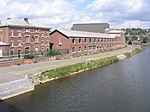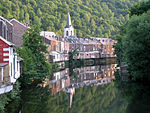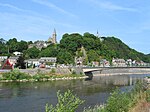Vesdre

The Vesdre (French, French pronunciation: [vɛsdʁ]) or Weser (German, German pronunciation: [ˈveːzɐ] (listen)) and Vesder (Dutch, Dutch pronunciation: [ˈvɛzdər]) is a river in Liège Province, eastern Belgium. A few kilometres of the upper reaches also flow through the German municipality Roetgen and form part of the Belgian–German border. The Vesdre's total length is approximately 64 kilometres (40 mi). It is a right tributary to the river Ourthe. Its source lies in the High Fens (Hautes Fagnes, Hohes Venn, Hoge Venen), close to the border with Germany near Monschau. It flows through an artificial lake (Lake Eupen), and then through the towns of Eupen, Verviers, Pepinster and Chaudfontaine. The Vesdre flows into the Ourthe a few kilometres from Liège where the Ourthe in turn flows into the river Meuse. The water of the Vesdre has a high acidity (due to the Hautes Fagnes bogs), which made it very suitable for the textiles industry around Verviers. The Vesdre was the far eastern end of the sillon industriel, the backbone of Walloon industry. Nowadays, the water of the Vesdre is mainly used as drinking water.
Excerpt from the Wikipedia article Vesdre (License: CC BY-SA 3.0, Authors, Images).Vesdre
Quai des Ardennes, Liège
Geographical coordinates (GPS) Address Nearby Places Show on map
Geographical coordinates (GPS)
| Latitude | Longitude |
|---|---|
| N 50.6116 ° | E 5.6135 ° |
Address
Quai des Ardennes
4032 Liège
Liège, Belgium
Open on Google Maps










